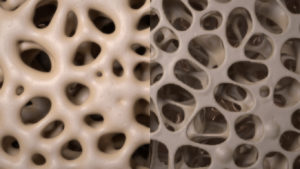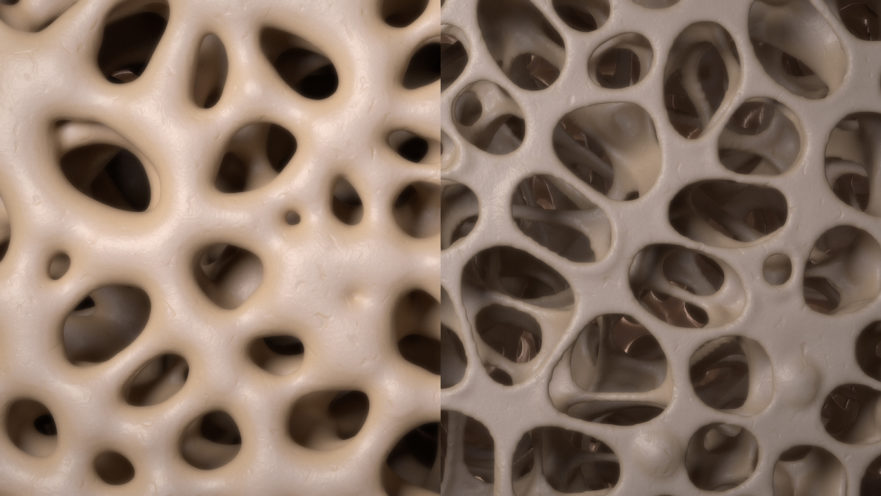 What is Osteoporosis?
What is Osteoporosis?
Osteoporosis is a sneaky skeletal disease in which bones become demineralized and porous, increasing the risk of fracturing.
Breaking a bone due to osteoporosis is very common and happens to one in two women and one in four men in the United States. Unfortunately, most people only realize they have the condition once a bone fractures and it is too late. However, a healthy lifestyle which includes strength training can prevent and even reverse the effects of this disease.
How do we develop Osteoporosis?
Until our mid-30s, our bones are constantly remodeling themselves, removing and reabsorbing nutrients to strengthen and elongate. The two cells involved in this process are osteoblasts and osteoclasts. Osteoblasts tell the body to build bones. Osteoclasts tell the body to break down bone and release the stored minerals. Osteoporosis happens when osteoclasts work faster than osteoblasts and bone is broken down at a faster rate than it is built.
While there are many factors involved in bone health, good nutrition aids the remodeling process and helps our bodies maintain bone density.
Paleo and Osteoporosis
Contrary to what critics may say, the Paleo diet and lifestyle promotes healthy bones. Our Paleolithic ancestors didn’t drink any milk after infancy and had much bigger and denser bones than us. The hunter-gatherer lifestyle of our ancestors promoted strong bones and excellent health.
Modern-day hunter gatherers like the Kitavan in Papua New Guinea consume no dairy and do not develop osteoporosis or other degenerative diseases. On the contrary, cultures such as Sweden and the United States, which have diets high in dairy, actually have the highest rates of bone fractures.
What can we learn from these primitive cultures?
The Kitavan and Paleolithic hunter-gatherer tribes ate a diet high in non-dairy calcium, fat-soluble vitamins A and D and other nutrients. So we know that certain vitamins and minerals are critical in maintaining and restoring bone health.
Calcium
You might be surprised to learn that our bodies need less calcium than the government’s nutrition guidelines suggest. The recommended dietary intake for calcium is from 1000 to 1300 mg/day. However, research shows that fractures are less common with intakes from 600 to 800 mg/day. Some studies even suggest that dairy consumption can increase the risk of osteoporosis, while plant consumption is correlated to bone health.
Seafood, fruits, vegetables, nuts and seeds are great sources of calcium. Eating just 2 cups of leafy greens and a can of sardines with bones would give you a sufficient daily intake of calcium.
Fat-Soluble Vitamins A, D, and K2
While calcium is a crucial nutrient involved in bone health, fat-soluble vitamins A, D, and K2 also play important roles.
The way it works is that Vitamins A and D are involved in reabsorption of nutrients and formation of new and healthy bone. Vitamin K2 is responsible for depositing our dietary calcium into bones, where it can be readily released when our calcium blood levels drop.
Scientists recommend a diet of 3 egg yolks a day and a weekly intake of liver, dark chicken meat, or cod liver oil to get these nutrients. Vitamin A is also available in dark green and orange vegetables and sunshine is a great natural source of Vitamin D.
To supplement a bone-healthy, Paleo diet, there are certain kinds of exercises that especially promote bone health. Hint: it’s not running.
Strength Training
Strength training is a great way to resist loss of bone mass and decrease your risk of osteoporosis. Participating in progressive training using foot-based, full body movements, like those of our ancestors, protects your bones and helps them stay strong as you age. One study found that just 30 minutes, twice a week, of strength training improved bone density, structure and strength in women with low bone mass.
High-intensity strength training has the most potent effect on bone density. It can include exercises such as kettlebell swings and bodyweight squats. The stress put on your bones during strength training fuels the bone remodeling process.
How One Woman Reversed Her Osteoporosis
Anne J came to Fitness Transform after being diagnosed with osteoporosis. She was reluctant to take medication with the negative side effects and wanted a more natural way to rebuild her bones. Within six months after shifting to a Paleo diet and rigorous strength training, Anne reversed her osteoporosis! Click here to read her amazing testimonial!
Don’t wait until osteoporosis creeps up on you. Cultivating a healthy diet and fitness regime from an evolutionary standpoint is the best preventative action you can take.
If you would like to learn more about the fitness and nutrition programs we offer, request a free consultation today!

